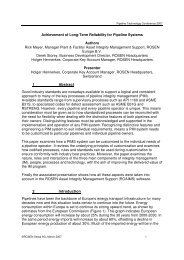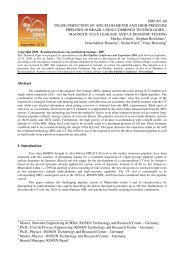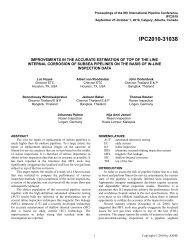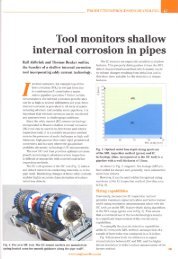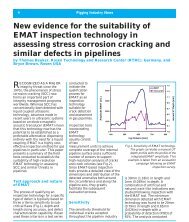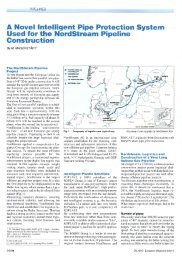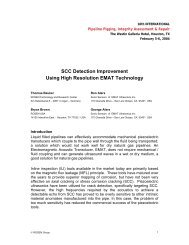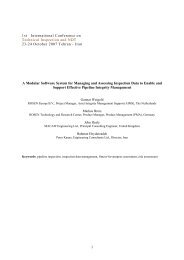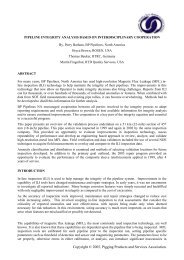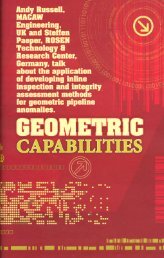in-line inspection of co2 pipelines - ROSEN Inspection Technologies
in-line inspection of co2 pipelines - ROSEN Inspection Technologies
in-line inspection of co2 pipelines - ROSEN Inspection Technologies
Create successful ePaper yourself
Turn your PDF publications into a flip-book with our unique Google optimized e-Paper software.
Document Name <strong>ROSEN</strong> CO2 - F<strong>in</strong>al Paper 01_20110614<br />
Revision Date 21-Sep-11<br />
Empowered by Technology<br />
www.rosen<strong>in</strong>spection.net<br />
reactive chemically, this supercritical condition makes it a very strong solvent. The<br />
size and shape <strong>of</strong> the molecules allow it to diffuse <strong>in</strong>to nearly every type <strong>of</strong> rubber or<br />
plastic material, hence its critical effect on numerous parts <strong>of</strong> <strong>in</strong>spection tools, such as<br />
cables, sensors and seals.<br />
Another critical issue <strong>of</strong> CO 2 is when it is comb<strong>in</strong>ed with water. This mixture creates<br />
carbonic acid which causes corrosion <strong>in</strong> pipel<strong>in</strong>es. Therefore, the CO 2 must be very<br />
dry when transported. This particular corrosion phenomenon has two ma<strong>in</strong><br />
consequences on pigg<strong>in</strong>g:<br />
� the dry surface <strong>of</strong> the pipel<strong>in</strong>e causes high wear on the slid<strong>in</strong>g part <strong>of</strong> the tool,<br />
especially the cups and discs<br />
� the dry environment prevents the equalization <strong>of</strong> potential electrical conductivity.<br />
The extreme wear on the carry<strong>in</strong>g and seal<strong>in</strong>g elements is a crucial issue for pigg<strong>in</strong>g,<br />
as the performance <strong>of</strong> these elements is the def<strong>in</strong><strong>in</strong>g parameter <strong>of</strong> the achievable<br />
piggable length <strong>of</strong> the pipel<strong>in</strong>e. Alternative solutions like support wheels are also<br />
affected by this extreme environment (miss<strong>in</strong>g or dissolved lubricants, dust<br />
contam<strong>in</strong>ation ) yet not just because <strong>of</strong> the dry environment, but namely due to the<br />
deterioration caused by the diffusion <strong>of</strong> the CO 2 <strong>in</strong>to the surface <strong>of</strong> the cups and discs.<br />
Other effects <strong>of</strong> the dry environment <strong>in</strong> pipel<strong>in</strong>es are more <strong>in</strong>direct and depend on the<br />
actual design <strong>of</strong> the <strong>in</strong>spection tool. The potential electrostatic charge can be built up<br />
by the movement <strong>of</strong> the cups along the pipe wall. This conductivity is stored on the<br />
surface <strong>of</strong> the entire tool and can create very high voltages between the tool and the<br />
pipel<strong>in</strong>e. This will be discharged either by a conductive contact or jump over.<br />
Depend<strong>in</strong>g on the position and <strong>in</strong>tensity <strong>of</strong> this discharge and the <strong>in</strong>volved areas <strong>of</strong><br />
the <strong>in</strong>spection tool, this can lead to serious damage to electronic parts. Particularly<br />
fast and high perform<strong>in</strong>g electronic devices, such as those <strong>in</strong> <strong>in</strong>-l<strong>in</strong>e <strong>in</strong>spection tools,<br />
are sensitive to these electrical discharges.<br />
A further effect <strong>of</strong> the diffused medium <strong>in</strong> the plastic materials is caused by the<br />
decompression <strong>of</strong> the tool environment. That means the surround<strong>in</strong>g pressure is<br />
reduced by vent<strong>in</strong>g the receiver <strong>of</strong> the pipel<strong>in</strong>e. The Joule-Thomson Effect <strong>in</strong>dicates<br />
that the expansion <strong>of</strong> a gas leads to decreased temperatures. This can result <strong>in</strong><br />
temperatures far below zero degree C with correspond<strong>in</strong>g effects on the electronic<br />
and plastic materials <strong>of</strong> the tool. However, when the tool is not operat<strong>in</strong>g or mov<strong>in</strong>g<br />
anymore, the consequences <strong>of</strong> this are not critical. Explosive decompression also<br />
affects the <strong>in</strong>tegrity <strong>of</strong> an <strong>in</strong>spection tool, when the medium diffuses <strong>in</strong>to plastic<br />
materials. S<strong>in</strong>ce no plastic and rubber materials are completely impermeable to gas<br />
diffusion, a certa<strong>in</strong> volume <strong>of</strong> the CO 2 will be absorbed <strong>in</strong>to the material. When the<br />
pressure <strong>in</strong> the receiver is released, CO 2 will partly diffuse out <strong>of</strong> the material. In some<br />
areas <strong>of</strong> the material however, there will be an accumulation <strong>of</strong> trapped CO 2. With<br />
reduced external pressure the CO 2 will expand <strong>in</strong> the material creat<strong>in</strong>g bubbles on the<br />
surface. These bubbles may collapse aga<strong>in</strong> or burst if the amount <strong>of</strong> CO 2 it too large.<br />
This is called “explosive decompression” and is a very detrimental phenomenon for<br />
cables, elastomeric or rubber parts on an <strong>in</strong>spection tool.<br />
Transportation <strong>of</strong> CO2 by Pipel<strong>in</strong>e page 2 <strong>of</strong> 12



